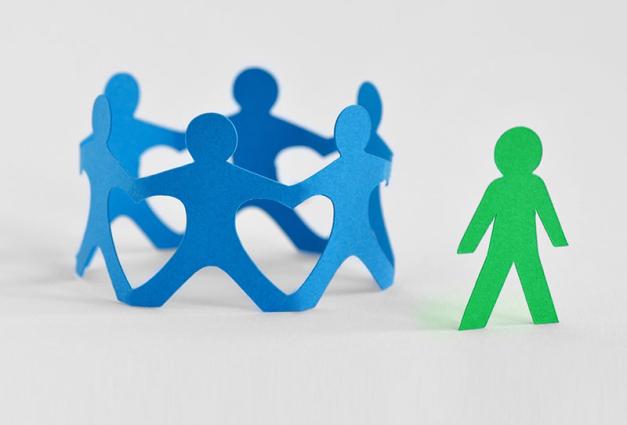We are living in a moment when many White Americans are trying to understand the complex, difficult, persistent, and often systemic issues that people of color face in the United States. Although we can learn a great deal by listening to people discuss their experiences and verbalize their pain, it isn’t always easy to put ourselves in someone else’s shoes and imagine something that’s completely outside of our experience.
I think we may be able to understand a small, but important, part of the experience of being the member of a minority group in America by thinking about the experiences of social exclusion we all face in our lives. Even people who don’t persistently face discrimination likely have insight into the pain of feeling like an outsider. I’ve spent the last 15 years studying social exclusion in its various incarnations, such as being told one is unwanted (interpersonal rejection) and being ignored and treated as if one is invisible and does not exist (ostracism). And, people can feel excluded in both their interpersonal relationships and at the societal level when they receive messages that their social groups are devalued and marginalized by mainstream society (stigmatization).
Being excluded in these ways is emotionally painful, threatening people’s basic psychological needs, such as their need for belonging, control, meaningful existence, and self-esteem. Individuals who experience chronic forms of exclusion often develop a sense of resignation as well as feelings of alienation, helplessness, depression, and existential meaninglessness. Many of these feelings are echoed in messages from people of color at rallies, in interviews, and on social media. These feelings were summed up poignantly by actor John Boyega in a recent speech in London’s Hyde Park: “I need you to understand how painful it is to be reminded every day that your race means nothing.”
Although some racism is blatant and explicit, people of color often experience quite subtle communications that they are devalued by and excluded from mainstream society, often daily. These experiences, typically called microaggressions, are painful to those who experience them. Part of what makes microaggressions so insidious is that they often seem minor or ambiguous to observers, perhaps even invisible. As a result, people of color may second-guess their own assessment of the situation in exhausting rumination. When a person of color finally does discuss these experiences, they are often told that they “simply imagined it” or are “being too sensitive”—which is invalidating and can be considered a type of microaggression as well. Sadly, people of color run the risk of being re-traumatized in a cycle of microaggressions.
In many ways, these experiences parallel trends found in research on social exclusion. Many forms of social exclusion involve making someone feel ignored, and the ways in which people do this are often socially ambiguous and unobserved by others, such as refusing to give someone eye contact or giving them “the silent treatment.” Even ignoring someone’s social media post or leaving them out of the loop on important information can make people feel excluded. These behaviors are ambiguous enough to cause people who are excluded to ruminate on their assessment of the situation and allow observers to write off the excluded person as simply being “too sensitive.” Sound familiar?
My colleagues and I recently started examining microaggressions within the context of research on social exclusion. We have found preliminary evidence that individuals experience microaggressions in ways that are similar to more general forms of social exclusion such as interpersonal rejection and ostracism, at least in terms of threatening people’s psychological needs and causing people to feel excluded.
Considering microaggressions in the context of social exclusion provides a way to broach discussions about micro-aggressive episodes with individuals who do not experience them and are skeptical of their effects. People who have never experienced a racial microaggression may not understand what it is like to be in the shoes of a person who has, but almost everyone, regardless of their racial identity, has experienced other forms of social exclusion.
Imagining how it would be to feel constantly devalued, ignored, and excluded may help some White Americans get a small feel for what is it like to experience persistent discrimination. Of course, this is only a small part of the experience that people of color face. The experience of being a minority group member in America is much more complicated than just feeling excluded. However, exclusion is a part of the experience that everyone has had and even can experience vicariously, so perhaps considering one’s own experiences of exclusion provides a bridge for empathic understanding and dialogue, and ultimately some societal healing and change.
For Further Reading
Banks, B., Adams, D., Williams, C., & Pina, D. (2020). Preliminary investigation of efforts to improve awareness of racial microaggressions on campus. Journal of Underrepresented & Minority Progress, 4(1), 20-43.
Smart Richman, L., & Leary, M. R. (2009). Reactions to discrimination, stigmatization, ostracism, and other forms of interpersonal rejection: A multimotive model. Psychological Review, 116(2), 365-383.
Sue, D. W., Capodilupo, C. M., & Holder, A. (2008). Racial microaggressions in the life experience of Black Americans. Professional Psychology: Research and Practice, 39(3), 329-336.
Wesselmann, E. D., & Williams, K. D. (2017). Social life and social death: Inclusion, ostracism, and rejection in groups. Group Processes & Intergroup Relations, 20(5), 693-706.
Eric D. Wesselmann, PhD, is an Associate Professor in the Department of Psychology at Illinois State University. He studies the dynamics of social inclusion and exclusion in everyday life.




